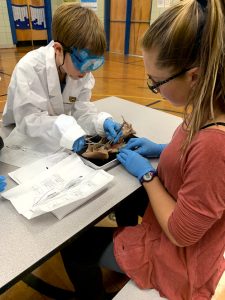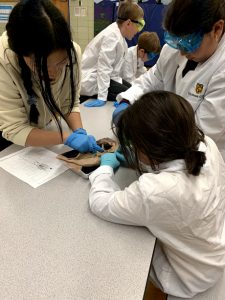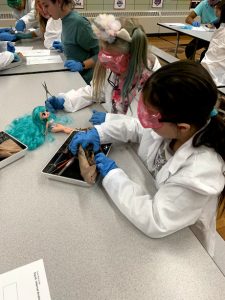When the CC Science Outreach are involved in a dissection, you know they aren’t squidding around!
For the most part.
For the past four years the CC Science Outreach program has collaborated with the 4th graders of Audubon Elementary School, teaching them about the ethics of working with animals through a squid dissection laboratory. Hearing this I immediately wanted to know as much as possible, so I asked the student leaders of the lab about their approach, speaking with senior leader Leo Brasuel he explained that “We like to introduce the lab with a brief discussion of bioethics and the scientific and academic value of the dissection process. Additionally, we provide some fun background facts on squid and talk a bout their basic anatomy,” he elaborated further, stating that “the students are always very enthusiastic and we generally partner each student or pair of students with one of our CC volunteers so that they can be guided through the dissection process and have the best learning experience possible.” The students, with their CC volunteers explore the anatomy of the squid, attempting to locate some of its harder to find body parts. “Some of the kids get a little squeamish at first, but they quickly get into learning about squid anatomy and dissection techniques,” however, as the lab continues the kids eventually are able to get the hang of everything, as senior leader Madeline M. Smith explains “one of their favorite things to find is the beak, which is the only hard thing in their body. They learn that a squid can fit through any hole as long as its beak can fit through it. Another cool squid fact is that their brain is donut shaped, and their digestive tract runs through the middle of it. The kids always get a kick out of that one!”
bout their basic anatomy,” he elaborated further, stating that “the students are always very enthusiastic and we generally partner each student or pair of students with one of our CC volunteers so that they can be guided through the dissection process and have the best learning experience possible.” The students, with their CC volunteers explore the anatomy of the squid, attempting to locate some of its harder to find body parts. “Some of the kids get a little squeamish at first, but they quickly get into learning about squid anatomy and dissection techniques,” however, as the lab continues the kids eventually are able to get the hang of everything, as senior leader Madeline M. Smith explains “one of their favorite things to find is the beak, which is the only hard thing in their body. They learn that a squid can fit through any hole as long as its beak can fit through it. Another cool squid fact is that their brain is donut shaped, and their digestive tract runs through the middle of it. The kids always get a kick out of that one!”
 The lab is not only valuable for the kids, but also for the student leaders, as junior Kim Faith recounts, “I originally did not know a lot about squids, so it was great to learn about their anatomy in a hands-on/interactive way. My favorite part was trying to find the ink sac and using it to draw. The two girls I was working with really enjoyed that part, and I thought it was fun too.” While this dissection seems incredibly entertaining it’s important to remind the children to not take dissections like these for granted, as Madeline M. Smith elaborates, “we remind the kids that these squid used to be living animals, and so we should respect them and not just chop them up for fun. Everything we dissect is for a reason.”
The lab is not only valuable for the kids, but also for the student leaders, as junior Kim Faith recounts, “I originally did not know a lot about squids, so it was great to learn about their anatomy in a hands-on/interactive way. My favorite part was trying to find the ink sac and using it to draw. The two girls I was working with really enjoyed that part, and I thought it was fun too.” While this dissection seems incredibly entertaining it’s important to remind the children to not take dissections like these for granted, as Madeline M. Smith elaborates, “we remind the kids that these squid used to be living animals, and so we should respect them and not just chop them up for fun. Everything we dissect is for a reason.”

Hopefully the CC Science Outreach will continue this incredibly important program, teaching kids not only on ethical values regarding animals, but also the common practices performed through scientific dissections. Knowledge that I wish I had developed in fourth grade.
